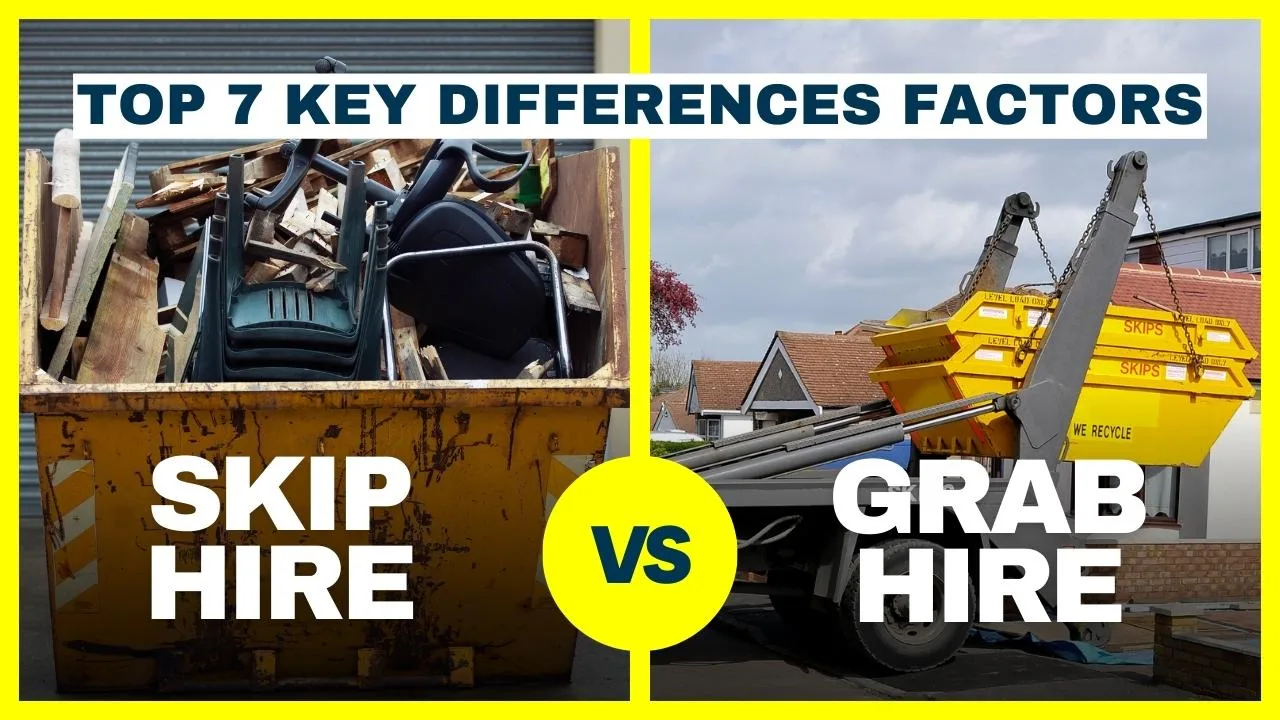Skip Hire VS Grab Hire: Best 5 Key Differences

Confused between Skip Hire VS Grab Hire?
Which one offers quicker waste removal and suits your project?
Let’s explore the differences, benefits, and find the optimal waste management solution for you.
In the realm of waste management solutions, two prominent options stand out: skip hire and grab hire.
Both methods offer efficient ways to handle waste disposal, but they cater to different scenarios and requirements.
In this article, we will go through the key differences between skip hire and grab hire, assisting homeowners, builders, contractors, businesses, and various professionals in making an informed choice based on their specific needs.
Table of Contents
Skip Hire VS Grab Hire: 7 Key Factors to Consider
Skip Hire
Skip hire has established itself as a reliable option in waste management, offering an effective means of waste collection and transportation. This approach involves the rental of skips, which come in a range of sizes from compact 2-yard options to expansive 16-yard containers.
The versatility of skip hire is evident in its ability to accommodate various types of waste, spanning from construction debris and household waste to garden waste. This flexibility extends to waste segregation within a single skip, making it appealing for those committed to recycling and responsible waste management practices.
- Efficient waste disposal solution through renting skips.
- Skips, large containers available in sizes ranging from 2 to 16 yards.
- Versatile, catering to various waste types including construction debris, household waste, and garden waste.
- Enables efficient waste segregation in a single container, aligning with recycling and responsible waste management goals.
Grab Hire
In contrast to the stationary nature of skips, grab hire introduces an element of dynamism to waste collection. This is achieved through specialized vehicles equipped with hydraulic arms, allowing for efficient loading of waste materials.
These grab lorries possess the ability to access challenging areas, making them especially valuable for sites with limited space or obstructed access. This characteristic renders grab hire particularly advantageous for construction projects dealing with large quantities of heavy and bulky waste. The speed of waste collection by grab lorries significantly reduces labor requirements and minimizes disruptions on the site.
- Dynamic waste collection through hydraulic-arm-equipped lorries.
- Excelling in accessing hard-to-reach areas, ideal for confined sites.
- Particularly beneficial for construction projects with bulky waste.
- Swift loading capabilities reduce labor and site disturbances.
Suitability for Different Scenarios
The choice between skip hire and grab hire hinges on the unique demands of each project. Residential projects often benefit from skip hire due to its inherent convenience.
Homeowners can have a skip conveniently placed on their property and fill it at their own pace. This flexibility proves advantageous for home renovations, thorough spring cleaning, or extensive garden projects.
Conversely, construction sites often grapple with the challenge of accumulating substantial volumes of waste within confined spaces.
In such scenarios, grab hire’s efficiency in loading heavy waste promptly emerges as a clear winner. Furthermore, landscaping and gardening projects frequently involve an assortment of waste types, making skip hire an ideal choice due to its ability to effectively segregate materials within separate skips.
- Skip hire suits residential needs with its convenience; homeowners fill skips at their pace.
- Grab hire excels on construction sites with limited space, effectively handling large waste volumes.
- Landscaping and gardening projects benefit from skip hire’s versatility in segregating diverse waste materials.
Cost Considerations
The financial aspect is a pivotal factor when choosing between skip hire and grab hire. For skip hire, costs are influenced by variables including the size of the skip, the duration of rental, and potential disposal fees.
Similarly, grab hire costs are impacted by these factors alongside the accessibility of the site for the grab lorry. To determine the cost-effectiveness of each method, it’s imperative to assess waste volume, the frequency of waste collection, and the availability of space for skip placement or grab lorry maneuvering.
By crunching these numbers, individuals and businesses can make decisions that align with their budget while effectively managing waste.
- Skip hire costs relate to skip size, rental duration, and potential disposal fees.
- Grab hire costs incorporate similar factors plus site accessibility for grab lorries.
- Cost-effectiveness depends on waste volume, collection frequency, and space availability.
Environmental Impact
Both skip hire and grab hire have their respective contributions to environmental sustainability. Skip hire promotes responsible waste disposal through effective segregation.
This practice allows for the separation of recyclable materials from general waste, fostering higher recycling rates and a reduced ecological footprint.
On the other hand, grab hire services play a crucial role in optimizing waste collection routes, resulting in fewer journeys and consequently reduced emissions.
Adhering to local regulations and waste disposal standards remains paramount to ensure that both methods uphold environmental responsibilities.
- Skip hire promotes recycling through efficient waste segregation, reducing the environmental footprint.
- Grab hire optimizes routes, minimizing trips and emissions, contributing to sustainability.
- Adhering to regulations ensures responsible waste disposal for both methods.
Ease of Use and Accessibility
Skip placement requires ample space and easy accessibility to facilitate loading. While skips offer a straightforward solution, there may be instances where limitations arise concerning their positioning.
This becomes especially relevant in urban or confined areas where space is a premium. In contrast, grab lorries offer an extended reach, enabling them to collect waste from spaces that might be inaccessible to traditional skip placement.
However, the practicality of each method depends on the specific layout of the site, the available space, and the logistical considerations at hand.
- Skip placement requires space and accessibility for loading.
- Grab lorries offer extended reach, collecting waste from confined areas.
- Practicality depends on site layout and logistical considerations.
Efficiency in Large-Scale Projects
Large-scale projects, such as construction sites or industrial facilities, inherently generate substantial amounts of waste.
In these scenarios, grab hire’s efficiency is particularly pronounced. The rapid loading capability of grab lorries allows them to handle significant waste volumes within a short timeframe.
However, it’s essential to note that for projects necessitating waste collection at multiple points within a site, coordinating several skips could potentially prove more practical and efficient.
- Grab hire efficiently handles substantial waste on large projects.
- Multiple skips coordinate for projects with diverse waste collection points.
Regulatory Compliance and Permits
Before embarking on either a thorough understanding of the regulatory landscape is imperative.
- skip hire or Skip placement often requires permits from local authorities, as the skips may encroach on public spaces.
- grab hire, Similarly, grab lorry operations must adhere to parking and licensing regulations. Navigating these legalities ensures the seamless execution of waste removal operations and prevents unnecessary disruptions.
- Skip placement requires local permits; grab lorry operations adhere to parking and licensing regulations.
Making the Informed Choice
When choosing between skip hire and grab hire, a thorough assessment of project requirements is crucial.
Skip Hire:
- Ideal for residential users seeking flexibility and gradual waste collection.
- Particularly suitable when ample space is available for skip placement.
Grab Hire:
- Beneficial for construction sites dealing with substantial waste loads and limited space.
- Offers the advantage of speed and accessibility.
Versatility of Skip Hire:
- Landscapers and gardeners benefit from skip hire’s versatility.
- Provides a pragmatic solution for projects involving various waste materials.
- Residential users find skip hire flexible; construction sites benefit from grab hire’s speed.
- Landscapers and gardeners leverage skip hire’s versatility for waste segregation.
Note: Exploring innovative skip hire alternatives opens the door to more sustainable and efficient waste management strategies, promoting environmental responsibility and cost-effectiveness.
Conclusion
The landscape of waste management continually evolves, and within it, skip hire and grab hire emerge as stalwart options. Each method possesses distinct advantages that cater to specific needs.
The ultimate decision between the two methods rests on factors such as waste type, project scope, site accessibility, and budgetary considerations.
By immersing themselves in the intricacies of skip hire and grab hire, individuals and organizations can make well-informed choices that not only address their waste disposal requirements but also contribute to environmental sustainability and the efficient execution of projects.






